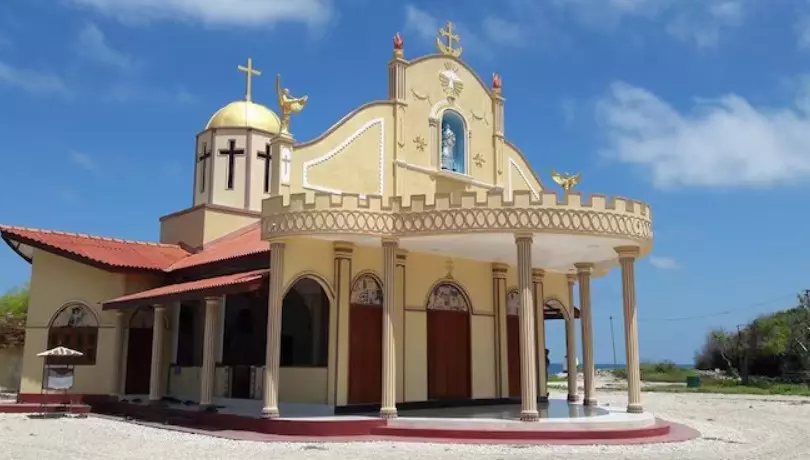TRENDING TAGS :
Katchatheevu Island history: British government also accepted that it was India's part, then how did Sri Lanka take it?
In such a situation, the question is, how did Katchatheevu island, which was a part of India for centuries, come under the control of Sri Lanka? Where is Katchatheevu Island? What is its story and what is its geography?
Before the Lok Sabha elections 2024, Katchatheevu Island history is once again becoming an election issue. Prime Minister Narendra Modi himself has said – This island was a part of India but the Congress government gave it to Sri Lanka. In such a situation, the question is, how did Katchatheevu island, which was a part of India for centuries, come under the control of Sri Lanka? Where is Katchatheevu Island? What is its story and what is its geography?
To understand this we will have to go back 144 years. That time is July 1880...A lease was signed between Edward Turner, the District Deputy Collector of Ramanathapuram, situated at the extreme end of Tamil Nadu, and the local Raja. Under the lease, the king was given ownership rights of 70 villages and 11 surrounding islands. Katchatheevu island was also one of these 11 islands. Five years later, another similar lease was made in 1885.
After this, in the year 1913, an agreement was signed between the King of Ramanathapuram and the Secretary of State of the Government of India. Katchatheevu island was also mentioned in this. You can also look at it from another perspective. The British government, which ruled both India and Sri Lanka, considered Katchatheevu to be a part of India and not Sri Lanka.
Now two questions arise here…where is Katchatheevu island and who was this king of Ramanathapuram? First answer to the first question... Robert Palk was the Governor of Madras Province between 1755 and 1763. He identified Ram Sethu or rather the Palk Strait present between India and Sri Lanka and this area of coral and sandy rocks was also named after him. Katchatheevu island is present in between. It is 12 miles from Rameshwaram, India and 10.5 miles from Nedundi, Jaffna. Its area is approximately 285 acres. Its maximum width is 300 meters.
According to Tamil language, this Katchatheevu means barren land. However, when you see its pictures, it is a very green area. A church was built here during the British rule, whose name is St. Antony's Church. Even now it is so revered that devotees from all over India come here every year for darshan. In the year 2023, the number of such devotees was more than 25 hundred. According to 'The Gazetteer', in the beginning of the 20th century, Seenikuppan Padayachi of Ramanathapuram had built a temple here and a priest of Thangachi Math used to worship in this temple.
Actually, the rulers of Ramanathapuram or Ramnad Empire had the title of Sethupati. It is said that when Lord Rama was returning after conquering Lanka, he gave the responsibility of protecting the bridge built by him to Lanka to some people. He was called Sethupati.
These Sethupati people were sometimes ruled by the Chola kings and sometimes by the people of the Pandya dynasty… later during the British rule, they were given zamindari by the British government. Katchatheevu island also remained under these rulers till 1947 i.e. till India's independence. Although a dispute over this was raised in the year 1925, when the King of Jaffnapatnam of Sri Lanka had claimed it as his territory, but the British rejected this claim.
Later, in 1974 and 1976, agreements were signed between the Government of India and Sri Lanka in which this island was handed over to Sri Lanka by the then Indira Gandhi government. Then her only opinion was that by giving this uninhabited island to Sri Lanka, good relations with the neighbor would be maintained. However, there was always opposition to it in Tamil Nadu. The then Tamil Nadu Chief Minister Karunanidhi had opposed it by passing a resolution in the Assembly.
After this, Jayalalithaa government also passed a resolution regarding Katchatheevu in the Assembly and the matter reached the Supreme Court. If seen, this is both an economic and emotional issue for Tamil Nadu. Economically because the fish stocks in the sea limits around Tamil Nadu are about to be exhausted. But there are abundant reserves of it around Katchatheevu. However, according to the agreement signed in 1974, Indian fishermen will use the island to dry their nets. Indians will not need a visa to visit the church built on the island. Apart from this, Indian fishermen will not be allowed to fish on the island. There was opposition then and even now regarding the third point of the agreement. Sri Lanka is so aggressive on this issue that in 20 years it has arrested 6184 Indian fishermen for violating the maritime border and has also seized 1175 Indian fishing boats. Now it remains to be seen what stand our neighbor and friend country Sri Lanka takes on this issue.



